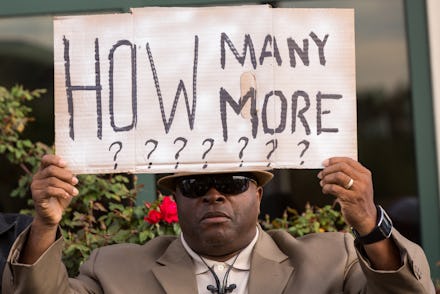41% of Unarmed Victims of Police Shootings Are Black

A South Carolina police officer was charged with murder Tuesday after the release of a video that captured him firing eight gunshots into the back of an unarmed black man running away from him.
The graphic video of the incident immediately provoked public outrage. The predatory nature of the shooting appeared to represent yet another obvious example of American law enforcement deeming black life dispensable. It comes not long after the killings of unarmed black men in Ferguson, Missouri, Staten Island, New York, and Cleveland last year, which set off a vigorous public debate about whether law enforcement officers are gratuitously violent in their policing of communities of color.
Central to this debate is the question of scope: Are these isolated incidents strung together by a compelling media narrative, or is the death of black men at the hands of the police part of a pervasive pattern of racial discrimination?
Using data from 2014 through March gathered by Mapping Police Violence, Reuben Fischer-Baum and Carl Bialik at FiveThirtyEight analyzed evidence that suggests the latter.
41% of unarmed people killed by the police across the country over the past year were African-American, while African-Americans make up only 14% of the national population.
In South Carolina, where the most recent shooting took place, 40% of unarmed people killed by the police have been African-American, according to FiveThirtyEight. The state's population is only 29% African-American.
More striking is the national rate: 41% of unarmed people killed by the police across the country have been African-American, while African-Americans make up only 14% of the national population. That means that African-Americans are overrepresented in police fatalities by a factor of three.
A skeptic might attempt to rebut this statistic as evidence of discrimination by pointing out that perhaps the black population is itself disproportionately likely to commit crimes or put themselves in dangerous scenarios. But in light of other staggering racial disparities in law enforcement, that reasoning is weak.
Discrimination is the norm: For example, across the country, a black person is nearly four times more likely to be arrested for marijuana possession than a white person, even through they use the drug at similar rates.
Young black men are 21 times more likely to be the victim of deadly force by the police than their white peers (primarily by white police officers), which dwarfs even right-wing estimates of black crime outpacing white crime.
These patterns of overrepresentation manifest themselves in every realm of the vast criminal justice system, from random stops by the police to length of incarceration.
The media isn't always savvy when detecting big picture trends, but its constant suggestion that black men are being systematically brutalized by the police isn't just correct — it's overdue.